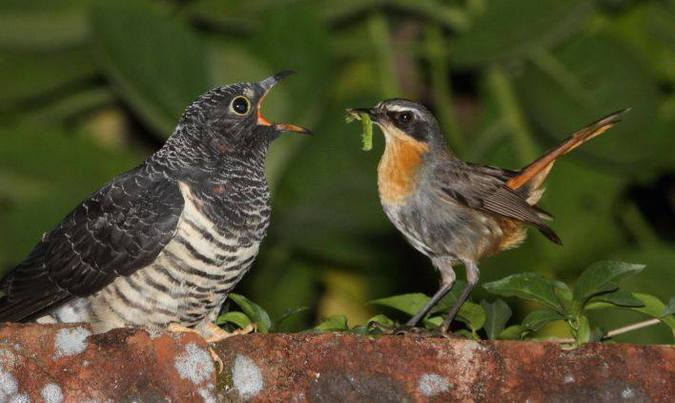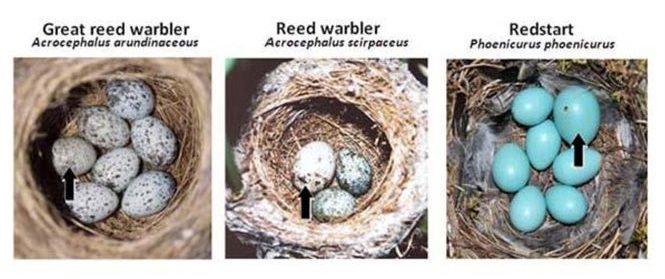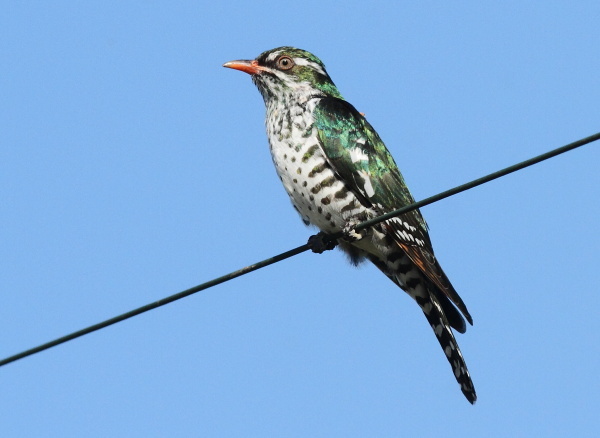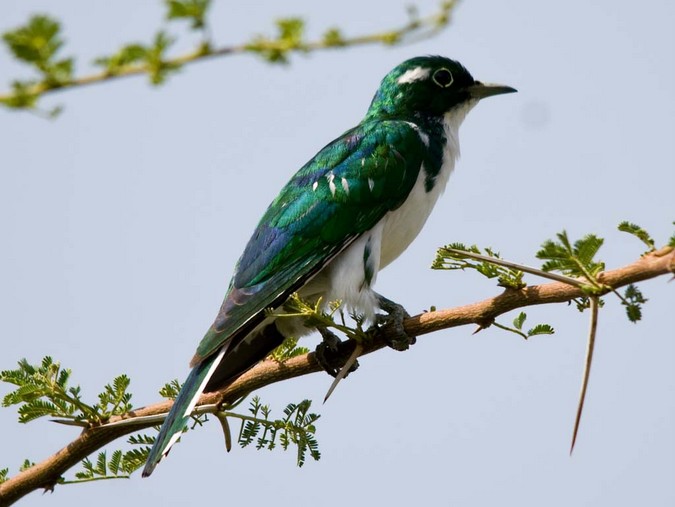
Cape robin-chat feeding a juvenile red-chested cuckoo © Alandmanson / WikiCommons
Written by Ben Coley from Bushwise
The African bush is teeming with fascinating organisms. Tourists from all over the globe flock to our biodiverse shores hoping for incredible sightings of lions, elephants and rhinos. But as any guide will tell you, despite their best efforts, sometimes finding these fabled animals is harder than it may sound. The Big 5 and other prominent animals are only a tiny cog in the wheel of the bushveld and thus it is imperative that guides have a sound working knowledge of ALL aspects of the bush.
Something that you are guaranteed to find on a game drive is birds… These remarkable creatures are often not given the credit they deserve, which is a shame because some of their adaptations and behaviours are truly unique. For me personally – as an official ‘bird nerd’! – perhaps the most amazing behaviour to discuss with guests is brood parasitism: the laying of eggs in another species’ nest and deferring all parental duties to the host bird.
Parenting, as many people would agree with, is one of the most stressful parts of life. The responsibilities thrust upon parents are huge. Be it the energy expended in nest building, the stresses of protecting and incubating the eggs, or the need to procure food for ravenous young, this is undoubtedly a strain on all animals. The best way to deal with this problem: pass the buck and make it someone else’s problem! Brood parasitism is exactly this. Why waste time and energy parenting when you can dupe someone else into doing it for you!
The most famous group of birds that practice this underhanded method is the cuckoos (although it is worth mentioning that the coucals are in the same family but are not parasites). Other species include honeyguides, whydahs and indigo birds. In order to ensure that this unique ecological niche is not over exploited, these birds all parasitise different species: some only use unique hosts while others are less picky and may have a range of targets. Evolution has provided these birds with some genius adaptations to make this possible:
• Brood parasites can lay an egg in as little as 10 seconds! This enables them to get in and out of a nest without alerting the parents to the deception taking place.
• Some birds can count and thus many brood parasites will eject an egg after laying their own to ensure that the subterfuge is not noticed!
• Their egg shells are typically thicker than other birds, allowing extra protection against damage to the eggs.
• Eggs are usually almost identical to that of their host bird so as remain undetected amongst the clutch.

The eggs from the brood parasite mimic the colour, size and shape of the eggs of the host bird © Nature Education, courtesy of M. Honza, T. Grim, & C. Moskat
These adaptations are fascinating on their own, but the real ‘magic’ happens once the chicks hatch. Brood parasites have a very fast incubation period which means they usually hatch before their adopted brothers and sisters. This is vital in terms of development as it gives them a head start getting food from the host parents. This means they develop faster and can thus dominate the other chicks and ensure their survival. However, many brood parasite chicks are born with devious weaponry and the instinct to use it.
• Like the eggs, the gape (inside of the mouth) will also match that of the host. Mother’s key off these patterns and colours and thus if the chick exhibits the same detail, they will not be noticed as an impostor!
• Most cuckoos have a hollow back and upon hatching will use this depression to scoop up the unhatched eggs and eject them from the nest!
• They also have unusually large feet which are used to trample the other chicks and potentially kill them!
• The honeyguide family is unique in that the chicks are born with a ‘bill hook’ attached to the tip of their beak. This is used as a weapon to stab and kill the other chicks, thus removing competition to get the lion’s share of the food and parental support!
For those of you that now think brood parasites to be grossly unpleasant and vindictive, take some solace in the fact that some parasite’s chicks are reared in conjunction with their brethren without incident!

Diederik cuckoo © Buckham Birding
One cannot blame the parents – the egg was in their nest, the egg colour and gape of the newborn chick match their own offspring, so why would they not assume it to be their own… Even when the host bird is considerably smaller than the chick they are feeding, they seem blissfully unaware. Some cuckoos parasitise comparatively tiny hosts, yet despite this, the parents continue to nurture them as their own!
For me, the most amazing part of this behaviour is how the young chick does not suffer from an identity crisis. Even though the chicks grow up with a surrogate family it never loses sight of its own genetic lineage. Let’s use a Diederik cuckoo as an example which parasitises most weaver species:
• These birds do not get to imprint on the smell or patterns of their own species. In fact they do not even see another Diederik cuckoo until maturity, yet they know to mate with one and not their surrogate species.
• They do not learn the language of their own species yet they know it inherently.
• They are given no instruction with regard to how to behave as a brood parasite but will grow up with the knowledge to not build its own nest and to lay its eggs in another bird’s nest (how nature quells the maternal instinct present in almost every other female organism is amazing?!)
• They are not shown when and where to migrate each year, yet they know. (Most cuckoos are migratory whilst most of the hosts are not.)
This is one of nature’s true miracles. It is the epitome of the nature/nurture debate! If ever one needed proof of genetic knowledge surely this is it. Despite zero experience, all these behaviours are ingrained in its primitive brain from the day it is born and carried out flawlessly! The exact method by which this is possible remains a mystery but however it is done, it another remarkable story for guides to share with their guests as they introduce them to some of the smaller inhabitants of this great planet.

Klaas’s cuckoo © Carol Foil


